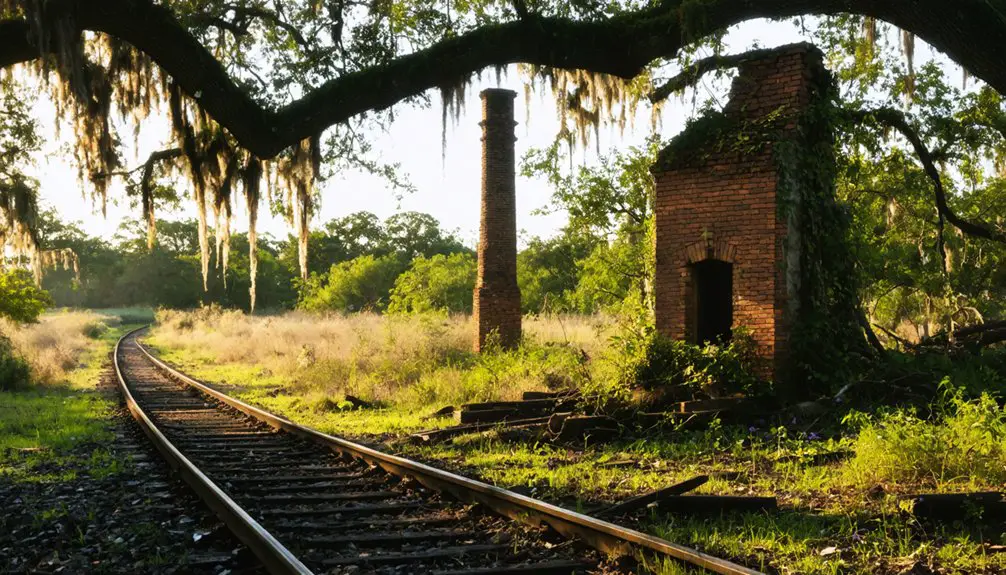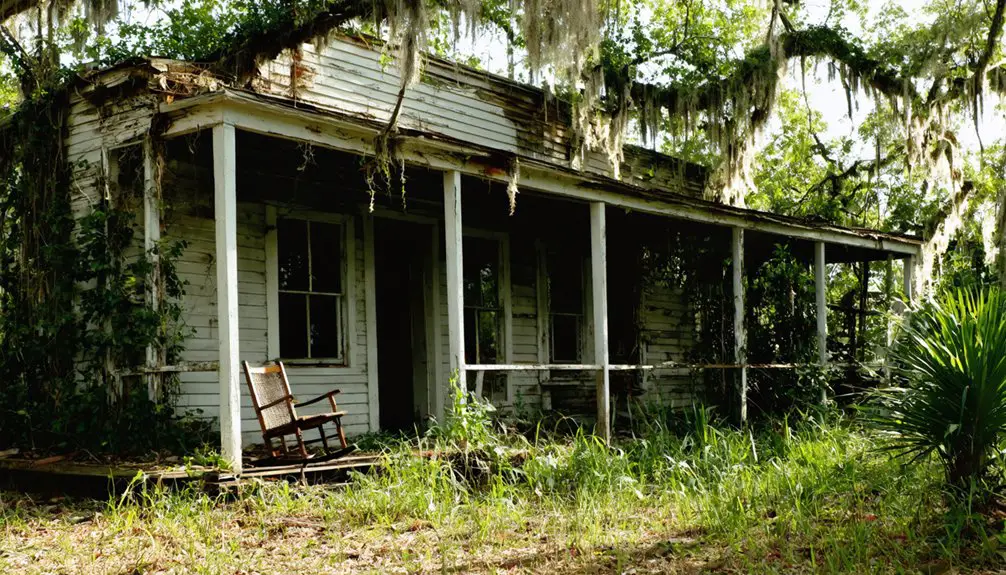You’ll find Rochelle’s ghost town remains 15 miles southeast of Gainesville, where this former railroad hub once thrived with 175 residents and 24 daily trains in the 1880s. Originally called Perry Junction, then Gruelle, the town reached its peak as Rochelle until the devastating citrus freezes of 1894-95 forced most residents to abandon their land. Today, landmarks like the 1885 Rochelle School House and historic cemetery hold secrets of this lost Florida community.
Key Takeaways
- Rochelle transformed from a bustling railroad town of 175 residents to a ghost town following devastating citrus freezes in 1894-95.
- The town’s decline began when property values plummeted from $1,000 to $10 per acre after the Great Freeze destroyed citrus crops.
- Originally named Perry Junction, then Gruelle, Rochelle was a thriving railroad junction handling 24 trains daily in the 1880s.
- Mass exodus occurred as farmers couldn’t afford to replant citrus trees, leading to abandoned buildings and empty streets.
- Historic landmarks remain today, including the 1885 Martha Perry Institute and abandoned Methodist church, preserving the ghost town’s legacy.
A Town’s Three Names Through History
The story of Rochelle’s evolving identity begins with Perry Junction, a settlement named after Florida Governor Madison Starke Perry in the 1840s.
You’ll find name significance in each of the town’s three iterations, reflecting the changing forces that shaped this community. In 1881, the town became Gruelle, honoring the Florida Southern Railway manager who brought crucial rail connections to the area. Finally in 1884, the settlement received its current name of Rochelle, marking its third and final designation. The town grew steadily and established itself as a thriving community with stores and sawmills by 1883.
Rise of a Railroad Community
You’ll find Rochelle’s transformation began in 1881 when the Florida Southern Railway established the town as an essential junction between Jacksonville and St. Petersburg.
The strategic location at Perry Junction drew approximately 100 residents by the late 19th century, with homes and businesses sprouting up around the bustling rail lines that carried lumber, produce, and passengers. The railway operated an impressive twenty-five trains daily through the stop. The town was previously known as Perry Junction before being renamed Gruelle.
The railway’s presence powered local growth through the 1880s, enabling citrus farmers to ship their harvests to distant markets while supporting critical community institutions like the Martha Perry Institute.
Railroad Fuels Town Growth
While many Florida towns emerged gradually in the late 19th century, Rochelle’s growth accelerated dramatically after Florida Southern Railway’s arrival in 1882.
You’d have witnessed the railroad impact transform this rural outpost into a bustling transportation hub, with 24 daily trains connecting Jacksonville to St. Petersburg by 1988.
The strategic rail link created unprecedented community growth, especially through agricultural commerce. Before railroads, overland travel through Florida’s swamps and forests made transportation extremely difficult.
The railroad’s standard gauge conversion in 1896 modernized operations significantly.
Here’s how the railroad fueled Rochelle’s expansion:
- Connected local farmers to wider markets through the Plant Railway System
- Established essential river access via the Rochelle Branch to Palatka
- Attracted specialized workers like railroad engineers and roadmasters
The town’s integration into the Atlantic Coast Line Railroad by 1903 cemented its position as an important link in Florida’s growing transportation network, fostering both economic and social development.
Perry Junction’s Strategic Location
Before becoming known as Rochelle, Perry Junction emerged as a significant railroad settlement named after Governor Madison Starke Perry, who owned 3,000 acres of prime Florida land during the 1840s.
The junction’s railroad importance became evident as it connected major routes between Gainesville, Ocala, and Palatka, while linking inland agriculture to essential port access via the St. Johns River.
You’ll find that by the late 1880s, this bustling hub handled up to 24 trains daily, showcasing its transportation legacy as a crucial connection point between Jacksonville and St. Petersburg.
The location’s strategic value supported thriving industries including citrus and lumber, while fostering community growth through schools, churches, and businesses. Like many communities requiring clear place name disambiguation, the town was carefully distinguished from other Rochelles across America.
The town was briefly named Gruelle in 1881 before becoming Rochelle in 1884, with its identity remaining deeply tied to its railroad roots.
Peak Years and Small-Town Life
During its peak in the mid-1880s, Rochelle flourished as a bustling railway town of 175 residents, where daily life revolved around its essential railroad junction connecting Gainesville, Ocala, and Palatka. The town, originally called Perry Junction, was named to honor Governor Madison Starke Perry.
In bustling 1880s Rochelle, 175 residents built their lives around the vital railroad hub linking three major Florida towns.
You’d find a vibrant community centered around agricultural practices, with cotton gins, gristmills, and sawmills driving the local economy. Community interactions thrived in schools, churches, and the town’s hotel, where residents gathered to share news and conduct business. The devastating 1895 citrus freeze marked the beginning of the town’s decline.
Here’s what made Rochelle truly dynamic:
- 24 trains passed through daily, moving goods and connecting communities
- Two schools served both white and black students, with the Martha Perry Institute becoming a social cornerstone
- Florida Cracker-style homes dotted the landscape, while farming families worked the surrounding fields
The Great Freeze That Changed Everything
You’d find Rochelle’s fate sealed during the catastrophic winter of 1894-95, when two devastating freezes plummeted temperatures into the teens and destroyed the town’s citrus groves.
The economic fallout hit Rochelle’s small farmers particularly hard, forcing many to abandon their land as property values crashed from $1,000 to just $10 per acre.
After losing their primary source of income, most of Rochelle’s residents left town in search of opportunities elsewhere, marking the beginning of its transformation into the ghost town you see today.
Devastating Winter of 1895
The winter of 1894-1895 brought unprecedented devastation to Rochelle’s farming community as two catastrophic freezes hammered the region.
You’d have witnessed temperatures plummeting to record lows, with Orlando hitting 18°F and Volusia County dropping to 16°F. The 1895 freeze delivered a knockout punch to local agriculture, destroying crops and splitting bark on citrus trees from top to bottom.
Here’s what made this winter particularly brutal:
- December’s initial freeze killed fruit and foliage while sparing mature roots.
- Warm spells between freezes triggered new growth, making trees vulnerable.
- February’s freeze proved fatal, freezing sap inside trees and killing entire groves.
The agricultural devastation forced many farmers to abandon their land, forever changing Rochelle’s landscape and pushing surviving growers southward to start anew.
Economic Impact and Exodus
Following those catastrophic freezes, Rochelle’s economic landscape crumbled with devastating speed.
You’d have witnessed the stark transformation as citrus groves, once valued at $1,000 per acre, plummeted to a mere $10. The town’s lifeblood – its citrus production – collapsed from 6 million boxes to just 100,000, triggering widespread economic migration as farmers and laborers fled west.
Those who stayed faced harsh realities. Many couldn’t afford to replant and wait seven years for new trees to bear fruit. Some turned to agricultural diversification, embracing tobacco farming and truck crops to survive.
But for Rochelle, these changes came too late. The exodus continued as families abandoned their homes, transforming this once-thriving citrus community into a ghost town, its empty streets evidence of nature’s cruel power.
Citrus Industry Never Recovered
While many Florida towns endured nature’s fury, Rochelle’s citrus industry faced a devastating one-two punch from the Great Freezes of 1884 and 1895.
You’ll find the impact of these freezes forever changed the town’s destiny, marking the beginning of its citrus decline. When temperatures plunged to 10 degrees in February 1895, it shattered any hopes of recovery that remained after the 1884 freeze.
The catastrophic impact led to:
- Mass community abandonment as residents sought opportunities elsewhere
- Packing houses and infrastructure falling into disrepair and eventual ruin
- Commercial citrus production shifting permanently southward to more climate-friendly regions like Polk County
You won’t find any thriving orange groves in Rochelle today – the town’s once-proud citrus heritage exists only in memory, frozen in time by those devastating winter nights.
What Stands Today: Historic Landmarks
Modern-day visitors to Rochelle can explore several well-preserved landmarks that tell the story of this once-thriving railway town.
You’ll find the centerpiece of historic preservation in the 1885 Martha Perry Institute, now known as Rochelle School House, which still houses original desks and its school bell.
The town’s community heritage lives on through two churches, including an abandoned Methodist structure, while converted railway lines now serve as popular recreational trails.
The Bradley family home from the 1920s stands among other surviving homesteads, offering glimpses into rural Florida architecture.
Perhaps most significantly, you can visit Rochelle Cemetery, the final resting place of Governor Madison Starke Perry, though you’ll need local guidance to find its exact location.
Finding Rochelle’s Hidden Past

To uncover Rochelle’s hidden past, you’ll need to trace its evolution through three distinct name changes that mark pivotal moments in the town’s history. From Perry Junction to Gruelle, and finally to Rochelle, each name tells the story of a community shaped by railroad expansion and agricultural promise.
Local legends still echo through the abandoned streets where 24 trains once thundered past daily.
To discover the hidden stories of this ghost town:
- Visit the historic Martha Perry Institute, a representation of the town’s educational ambitions.
- Explore the old railroad path, now a bike trail, where commerce once flourished.
- Seek out Madison Starke Perry’s grave, connecting you to Florida’s Civil War era and the town’s earliest days.
Frequently Asked Questions
Are There Any Ghost Stories or Paranormal Activities Reported in Rochelle?
You won’t find documented haunted locations or eerie sightings here – while the town’s abandoned buildings and cemetery create a haunting atmosphere, there aren’t any officially reported paranormal activities or ghost stories.
What Happened to the Residents Who Left Rochelle After Its Decline?
You’ll find most former Rochelle residents moved to Gainesville and other nearby railway towns after 1895’s devastating freeze. Many of their descendants still live in Alachua County’s surrounding communities today.
Can Visitors Legally Explore and Photograph the Remaining Buildings Today?
You can explore and photograph buildings visible from public roads, but respect exploration rules and photography guidelines – many structures remain on private property requiring permission for access.
Did Any Famous People Besides Governor Perry Live in Rochelle?
You’d think a small railroad town would attract celebrities, but besides Governor Perry, the only notable historical figures were N.R. Gruelle, a railroad surveyor, and the locally prominent Bradley family.
Were There Any Major Crimes or Notable Incidents During Rochelle’s Peak Years?
You won’t find any documented major crimes or notable incidents in historical records from the 1800s peak years. The town’s crime history focused on peaceful agricultural life and railway development.
References
- https://laforgottenfrontier.wordpress.com/2014/02/18/rochelle-fla/
- http://www.desolationflorida.com/2015/10/rochelle-florida.html
- https://abandonedin360.com/abandoned-government-properties/rochelle-school-house/
- https://digitalcommons.unf.edu/historical_architecture_main/3742/
- https://www.ghosttowns.com/states/fl/rochelle.html
- https://www.wuft.org/untold-florida/2019-03-07/rochelles-trio-of-trees-witness-to-history
- https://www.wuft.org/business-news/2018-03-15/for-windsor-and-rochelle-citrus-and-weather-shaped-future
- https://en.wikipedia.org/wiki/Rochelle
- https://myfiles.dot.ga.gov/Environmental/CulturalResources/Appendix G_GSF_Final 100318.pdf
- https://theforgottensouth.com/jolly-house-alachua-florida/



